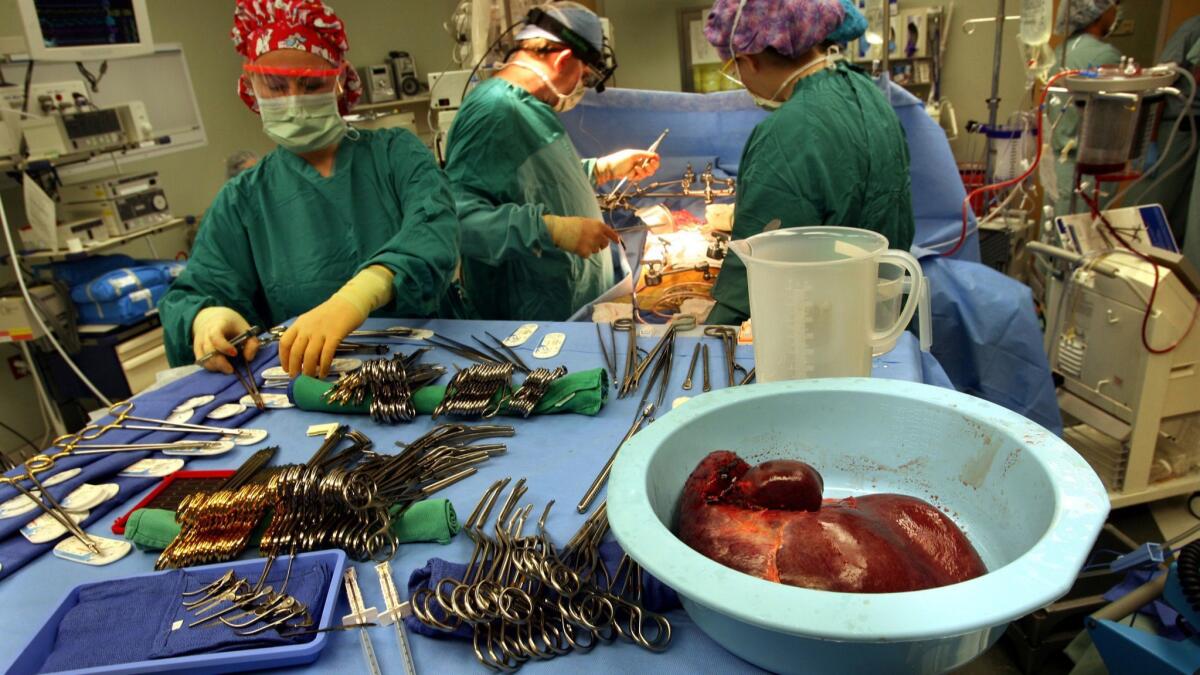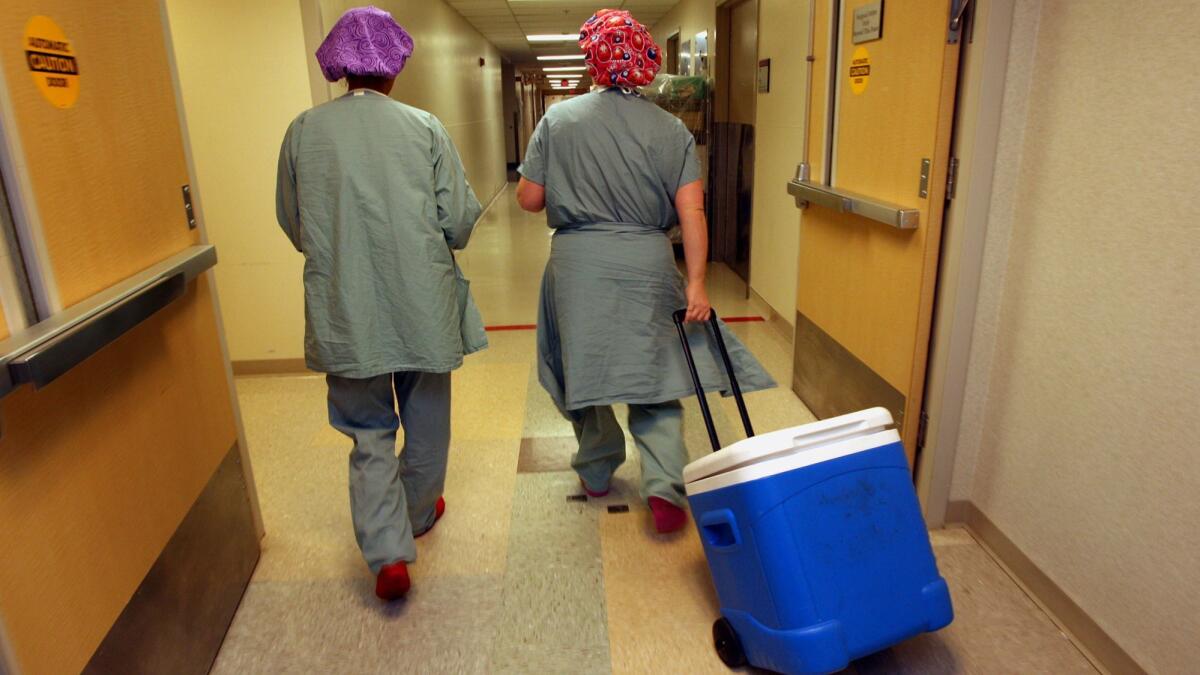Liver transplants are better all around when you hold the ice

- Share via
To preserve more livers for transplant patients who desperately need them, surgeons should take newly harvested organs out of their ice baths and immerse them instead in a warm, nutrient-rich soup, new research suggests.
In a head-to-head comparison of the two methods, preserving donor livers in conditions that mimic a living body resulted in 20% more organs being transplanted into patients, according to a study published Wednesday in the journal Nature.
“The ability to make good use of every possible donor we have is crucial” to saving lives and reducing the backlog of patients in need of a new liver, said Oxford University bioengineer Constantin Coussios, a study author who has been working on this for two decades.
For 30 years, newly harvested livers have been flushed with preservation fluid, then stored on ice until their prospective recipients were ready for surgery.
The new technique, called “normothermic preservation,” keeps the liver at body temperature and nourishes it with a continuous flow of oxygenated blood and other nutrients.
The researchers — known as the Consortium for Organ Preservation in Europe — tested the two methods in a rigorous, first-of-its-kind clinical trial.
Compared to the “cold storage” approach, the new practice caused less damage to donor livers, slashing the rate at which livers were “discarded” — harvested but never transplanted — in half.
After accounting for unavoidable rates of discard among all livers harvested for transplant, the researchers calculated that the warm-body approach resulted in 20% more transplanted organs.
That’s a lifesaving leap forward in a field where the demand for transplantable organs far outstrips supply. Though just under 14,000 patients are waiting for livers in the United States, only about 7,500 liver transplant surgeries were performed in the United States in 2016.
Moreover, while liver failure is on the rise in the United States, the quality and quantity of livers suitable for transplant appears to be declining as obesity, infectious disease and other societal ills erode the organs of prospective donors.
Dr. Ronald W. Busuttil, chairman of surgery at UCLA Medical Center and founder and chief of UCLA’s liver transplant division, called the new method “a very, very exciting new modality to revive and restore livers that might otherwise be discarded.”

The livers are maintained on a perfusion machine called Metra, which is made by a company called OrganOx. Coussios and one of his coauthors have a financial stake in the company. Neither was involved in the selection, recruitment or transplantation of patients in the study, which was funded by the European Commission.
In virtually all of the 121 transplants involving a liver maintained at body temperature, the organ continued to make bile, a key measure of its viability once transplanted, Coussios said.
An organ kept perfused with blood at 98.6 degrees Fahrenheit is “pretty much pink by time it’s delivered and makes a very rapid transition to normality once transplanted,” he said.
A number of complications that can doom a transplant recipient — from blood pressure changes in the operating room to organ failure or rejection after surgery — appeared to be reduced when the organ was essentially kept alive after it was harvested from its original body.
Although it was not among the outcomes the new study sought to explore, the authors also discovered that normothermic preservation extended the period of time a liver could remain viable after it was removed from its original owner and before it reached its new home in a transplant patient.
On average, a liver packed in ice can be preserved for seven to eight hours before its viability begins to decline, and 12 hours is considered the maximum time an organ can survive the cold. During the trial, logistical difficulties caused wait times to be a bit higher in the normothermic preservation group, and the researchers found that these organs remained viable for an average of 12 to 13 hours, and a maximum of 24 hours.
Lengthening the time an organ can be kept in a condition suitable for transplant could not only make many more available, it could allow livers to travel further for transplantation and give surgeons more latitude in deciding which patient is best suited for a particular organ.
At a time when transplant surgeons are declining to use many organs that become available for fear that they won’t help patients, normothermic preservation gives doctors an option they crave but do not now have, Coussios said: “to test-drive an organ” in advance of transplanting it.
That’s important because an increasing number of potential donors, and their organs, look like less-than-ideal candidates. When would-be donors are older, sicker, fatter or have died in ways that compromise the integrity of their organs, surgeons face a dilemma: They know these imperfect organs might help a patient, but they’re reluctant to risk an unsuccessful transplant.
In an ice bath, a harvested organ shows none of its positive attributes. It’s gray, inert and slowly dying, and its degradation produces chemicals that will spark inflammation in the recipient whose blood brings it back to life.
But if it has been maintained at body temperature and pumped with blood, a transplant surgeon can see what an organ is capable of, Coussios said. For instance, he or she can see whether the organ is able to maintain its chemical balance and produce the vital substances it will be called upon to make.
“It’s amazing,” said Busuttil, who was not involved in the new study but is part of a U.S. trial testing Metra. “You put a liver on a machine, and after it’s perfused for four to eight hours, it’s making bile, it’s soft, it seems to be an ideal organ.”
Coussios said the research team is confident that exchanging normothermic storage for cold storage will offer benefits for other organs as well. The new clinical trial results should be “a real watershed moment” for organ transplant practices, he said.
Busuttil also expressed confidence that the shift from ice baths to warm, pumped blood will “rejuvenate” a wide range of organs that transplant surgeons might otherwise pass over.
MORE IN SCIENCE
Organs from drug overdose victims could save the lives of patients on transplant waiting list
Attention women: Your choice of blood pressure medicine may affect your risk of pancreatic cancer
Corals on Great Barrier Reef will never be the same after back-to-back heat waves, scientists say
UPDATES:
6:30 p.m.: The story has been updated with comments from Dr. Ronald Busuttil of UCLA and with additional detail throughout.
The story was originally published at 11:30 a.m.







